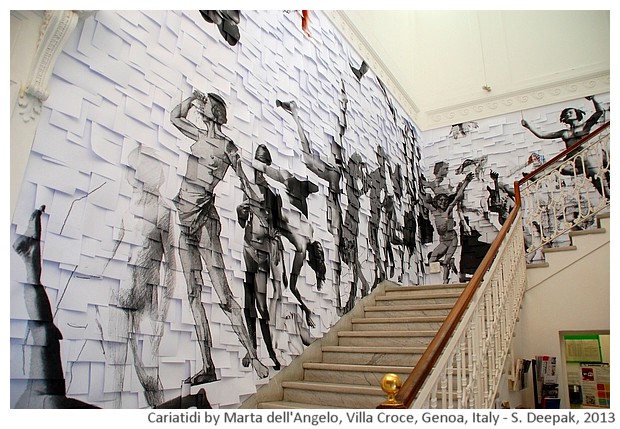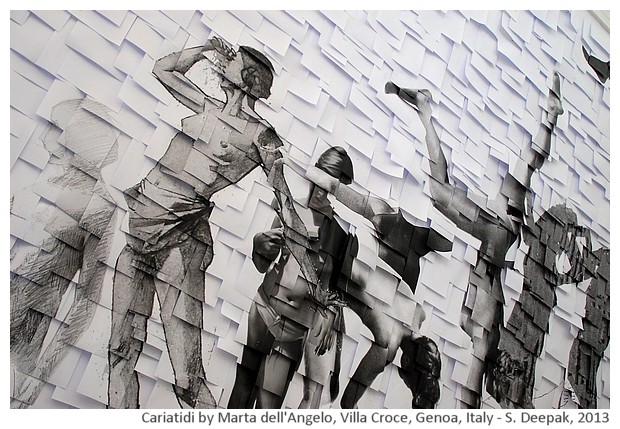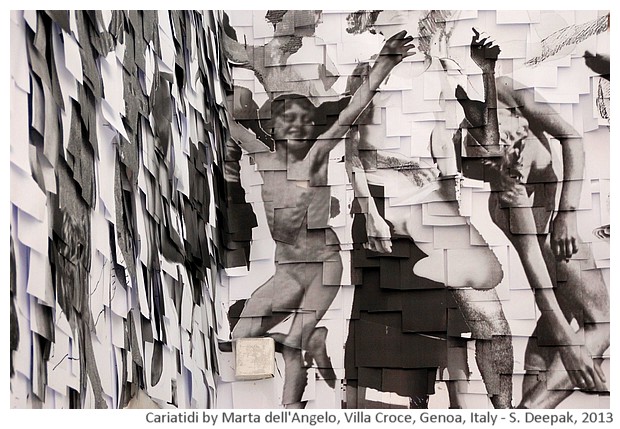


Genoa, Italy: Today's images have the art installation "Caryatids" (Women of Carie) by Italian artist Marta dell'Angelo. Made on 5000 sheets of paper, it shows women free from clothes and social restrictions. Carie was an ancient Greek town, from where enslaved women were used as models for making statues at a temple in Acropolise in Athens. For this reason, women-shaped pillars, used for making windows or doors, are called Caryatids. Clothes serve to protect us from cold, dust and sun. They are also chosen for beauty. Yet, since ancient times, societies have used clothes, through the norms of modesty and decency, to chain and bind women's bodies and minds. In India, poet-saint Akka Mahadevi from Karnataka rennounced clothes to break those chains. This art expresses similar feelings.
जेनोवा, इटलीः आज प्रस्तुत है इतालवी कलाकार मार्ता देल आँजेलो की कलाकृति "कारिआतिदी" यानि "कारिए की नारियाँ". इसमें उन्होंने 5000 कागज़ों पर वस्त्रों और समाज के बन्धनों से मुक्त नारी शरीर दिखाये हैं. कारिए प्राचीन यवन देश (ग्रीस) का शहर था जहाँ की गुलाम औरतों को मोडल बना कर एथेन्स की पहाड़ी पर बने मन्दिर की मूर्तियाँ बनायी गयी थीं. इस वजह से नारी-शरीर आकार के खम्बों को, जिनसे खिड़की या द्वार को बनाया जाये, उन्हें कारिआतिदी कहते हैं. वस्त्र सर्दी, धूल या धूप से बचने के लिए काम आते हैं. वस्त्रों में सुन्दरता भी है. पर प्राचीन समय से समाजों ने वस्त्रों को लज्जा और शालीनता के नियमों से बाँध कर नारी शरीर और सोच पर बन्धन लगाये हैं. भारत में कर्णाटक की कवियत्री-संत अक्का महादेवी ने इन्हीं बँधनों को तोड़ने के लिए वस्त्रों का त्याग किया था. यह कलाकृति उसी भाव को दर्शाती है.
Genova, Italia: Le immagini di oggi presentano l'opera "Cariatidi" (Le donne di Carie) dell'artista italiana Marta dell'Angelo. Creato su 5000 fogli di carta, l'opera presenta corpi femminili liberi dai vestiti e dalle restrizioni. Carie era un'antica città greca, da cui donne rese schiave erano utilizzate come modelle per costruire le statue nel tempio di Acropoli ad Atene. Per questo motivo, le colonne fatte come figure femminili, usate per costruire finestre o porte, si chiamano Cariatidi. I vestiti servono a ripararci dal freddo, dalla polvere e dal sole. Vestiti hanno anche un ruolo estetico. Ma fin dai tempi antichi, le società hanno utilizzato vestiti, tramite norme di modestia e di decenza, per incatenare i corpi e le menti delle donne. In Karnataka (India), la poeta-santa Akka Mahadevi, aveva rinunciato ai vestiti per rompere queste catene. Questa opera esprime simili sentimenti.
***
While some may call it 'art of anarchy', I go by the dictum: 'art for art sake.' Excellent work.
ReplyDeleteSociety has a lot to fear from such ideas that are seen as threatening to social order, that is how they call it "art of anarchy"! I call it art for provoking and stimulating, or even art for a social change :)
DeleteFabulous art!
ReplyDeleteI am glad that you like it Amit. Thanks :)
Deleteexcellent
ReplyDeleteThanks Mukhtiar :)
DeleteThanks Manu
ReplyDeleteInnovative art :-)
ReplyDeleteYes, who would have thought that computer and printers can become paint and brush for inventing art! :)
DeleteThanks Mousumi
Awesome art... With a message...
ReplyDeletethnaks Kcalpesh :)
Deletewith your photographs you always ignite a thought
ReplyDeleteThat is precisely the intention, so your comment means a lot to me. Thanks Cifar :)
DeleteIt surely is an expressionism of freedom, liberating and embracing the fearlessness.
ReplyDeleteFreedom from ourselves, from our own fears and insecurities, is as tough or even tougher than freedom from others!
DeleteThanks Rupertt
intersting photo
ReplyDeleteYou mean interesting art, may be! :)))
DeleteThanks Ashok